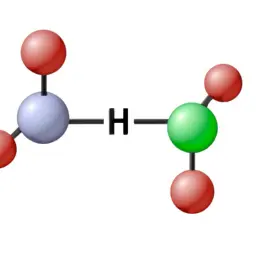
Chemical Bonding
Course Description
Chemical bonding is the process by which atoms combine to form molecules, ions, and other types of compounds. It is a fundamental concept in chemistry that plays a crucial role in determining the physical and chemical properties of substances. There are several types of chemical bonds, including ionic bonds, covalent bonds, metallic bonds, and hydrogen bonds.
Ionic Bonds: Ionic bonds are formed when one or more electrons are transferred from one atom to another. This results in the formation of positively charged cations and negatively charged anions, which are attracted to each other due to their opposite charges. Ionic compounds are typically composed of a metal cation and a non-metal anion.
For example, when sodium (Na) and chlorine (Cl) react, sodium loses one electron to form a positively charged ion (Na+), while chlorine gains one electron to form a negatively charged ion (Cl-). The resulting compound, sodium chloride (NaCl), is held together by the attraction between the oppositely charged ions.
Covalent Bonds: Covalent bonds are formed when two or more atoms share electrons in order to achieve a stable electron configuration. Covalent compounds are typically composed of non-metal atoms.
For example, in a molecule of water (H2O), each hydrogen atom shares one electron with the oxygen atom, resulting in a stable configuration for all three atoms. The covalent bonds in water are strong, but the intermolecular forces between water molecules are weak, resulting in properties such as high boiling point and surface tension.
Metallic Bonds: Metallic bonds are formed when metal atoms share a sea of electrons that are not associated with any particular atom. This results in a three-dimensional network of positive metal ions surrounded by a cloud of negative electrons. Metallic bonding is responsible for the unique properties of metals, such as high electrical conductivity and malleability.
For example, in a piece of copper (Cu), each copper atom shares electrons with neighboring copper atoms, resulting in a network of positive copper ions surrounded by a cloud of electrons.
Hydrogen Bonds: Hydrogen bonds are a special type of dipole-dipole interaction that occur when a hydrogen atom is covalently bonded to a highly electronegative atom, such as nitrogen, oxygen, or fluorine. The hydrogen atom has a partial positive charge, while the electronegative atom has a partial negative charge. These partial charges result in a strong electrostatic attraction between adjacent molecules.
For example, in a molecule of water (H2O), the hydrogen atoms are attracted to the oxygen atoms of neighboring molecules through hydrogen bonds. This results in the high surface tension and boiling point of water.
In conclusion, chemical bonding is a fundamental concept in chemistry that plays a crucial role in determining the physical and chemical properties of substances. The four main types of chemical bonds – ionic, covalent, metallic, and hydrogen – each have their own unique characteristics and properties. Understanding the nature of chemical bonds is essential for predicting the behavior of chemical systems and developing new materials with desirable properties.
Here are some additional interesting facts and scoring topics related to chemical bonding:
- Polarity: The polarity of a molecule is determined by the distribution of electrons in the molecule. If the electrons are evenly distributed, the molecule is non-polar, but if they are unevenly distributed, the molecule is polar. Polar molecules have a dipole moment, which means they have a positive end and a negative end. This is important in determining the solubility and reactivity of molecules.
- Lewis Structures: Lewis structures are diagrams that show the arrangement of atoms and valence electrons in a molecule. They are used to determine the type of chemical bonding in a molecule and predict its shape and polarity.
- Hybridization: Hybridization is the process by which orbitals of different types combine to form hybrid orbitals that are suitable for bonding. This is important in determining the geometry of molecules and the type of chemical bonding that occurs.
- Resonance: Resonance occurs when multiple Lewis structures can be drawn for a molecule, but none of them accurately describe the actual distribution of electrons in the molecule. Instead, the true structure of the molecule is a combination, or average, of the possible resonance structures.
- Intermolecular Forces: Intermolecular forces are the forces that exist between molecules. They include dipole-dipole forces, hydrogen bonding, and van der Waals forces. These forces determine the physical properties of substances, such as melting and boiling points, solubility, and viscosity.
- Applications: Understanding chemical bonding is essential in a variety of fields, including materials science, medicine, and environmental science. For example, chemists use knowledge of chemical bonding to develop new drugs with specific properties, create new materials with desired properties, and understand the behavior of pollutants in the environment.
In summary, chemical bonding is a complex and fascinating field of study that has many practical applications in science and technology. Understanding the nature of chemical bonds and the various types of bonding that can occur is essential for predicting the behavior of chemical systems and developing new materials with desirable properties.
Course Info
- Prerequisites: No



There are no reviews yet.